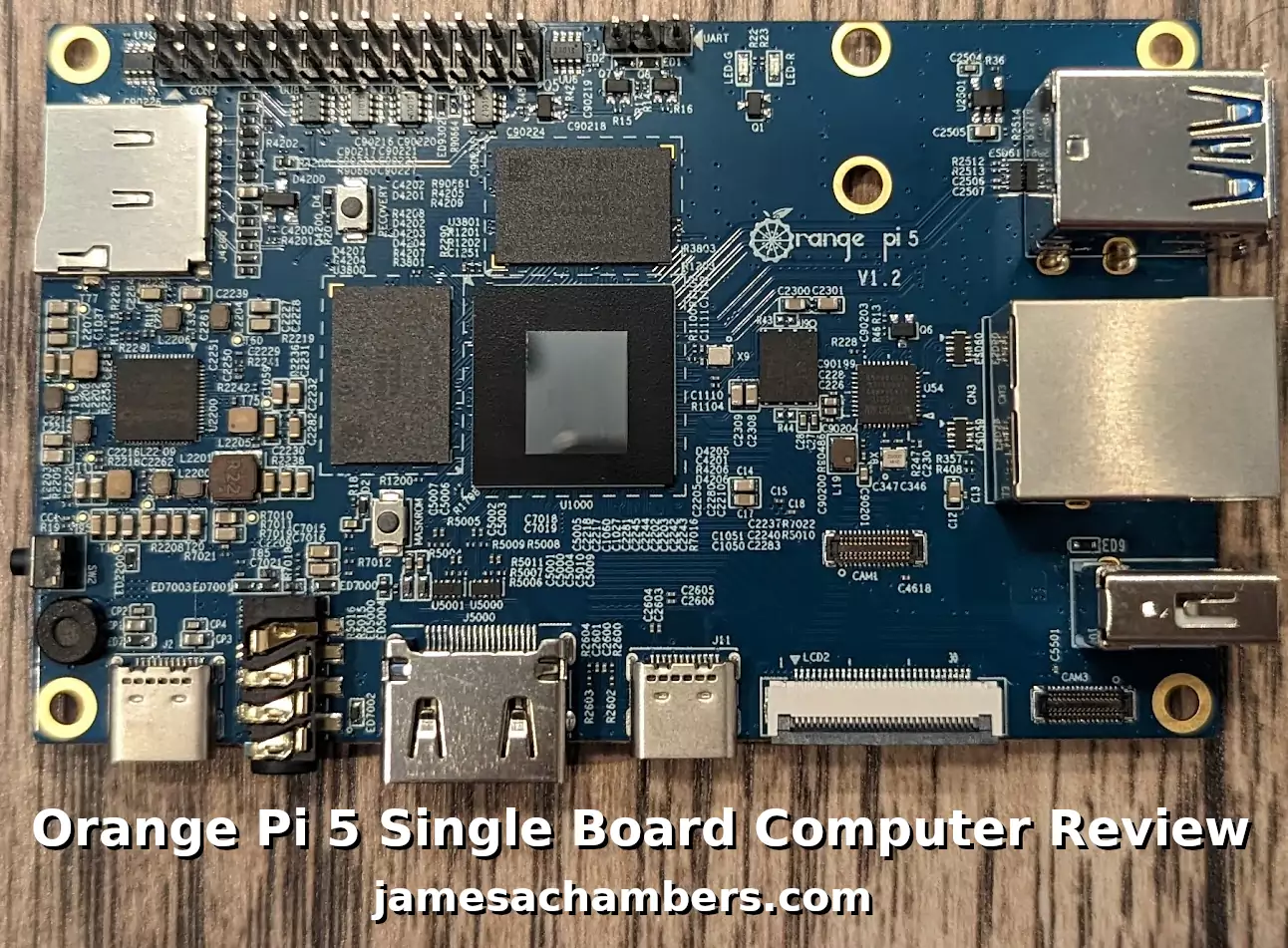
The Orange Pi 5 has finally arrived! I received my pre-order and the board is great. So should you go out and buy it? Probably, but there are some things you should know first that you may not be expecting.
The biggest thing to know is that there is no WiFi/Bluetooth included. If you were planning on using Ethernet anyway this doesn’t have much of an impact. If you do need wireless capabilities we’ll cover what options are available.
In this review we’ll cover what you need to know about the Orange Pi 5 including it’s onboard capabilities, the available RAM options as well as benchmark the board. Let’s get started!
Hardware Used
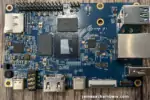
The Orange Pi 5 the latest release from Orange Pi and is the most powerful model yet. It has a 6 core CPU and options from 4GB of RAM all the way up to 32GB of RAM!
Links: Amazon.com*, AliExpress*, Amazon.ca*, Amazon.co.uk*, Amazon.de*, Amazon.es*, Amazon.fr*, Amazon.it*, Amazon.nl*, Amazon.pl*

The Geekworm copper heatsink set is designed to fit many different single board computers. It uses thermal conductive adhesive which many “cheap” heatsink kits for SBCs don’t have. Eliminates hotspots and reduces throttling. Can be further enhanced by powered cooling over the heatsinks.
Links: Amazon.com*, Amazon.ca*, Amazon.co.jp*, Amazon.co.uk*, Amazon.de*, Amazon.es*, Amazon.fr*, Amazon.it*
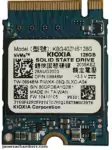
The Kioxia (Toshiba) 128GB M.2 2230 PCIe NVMe drive is much shorter than most NVMe drives (full size is 2280). It fits great with single board computers / tablets / other smaller form factors.
Links: Amazon.com*, Amazon.ca*, Amazon.co.uk*, Amazon.co.jp*, Amazon.com.au*, Amazon.de*, Amazon.es*, Amazon.fr*, Amazon.it*, Amazon.nl*, Amazon.pl*, Amazon.se*, Amazon.sg*

The Orange Pi official mouse uses 2.4GHz wireless to give you a wireless mouse experience with the Orange Pi
Links: Amazon.com*, AliExpress*

The Orange Pi monitor is meant to be a portable monitor you can take anywhere. It has a resolution of 1080P and features a hinge in the back that folds out to support the monitor.
Links: Amazon.com*, AliExpress*
Custom WiFi Module (Added 1/13/2023)
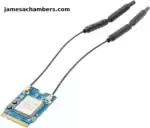
The Orange Pi 5 official wireless module is designed to fit into a M-keyed M.2 slot (the only one the Orange Pi 5 has). This WiFi adapter will work with both Linux and Android.
Links: Amazon.com*
Specifications
| CPU | 8-core 64-bit processor Big.Little Architecture: 4xCortex-A76 and 4xCortex-A55 Big core cluster is 2.4GHz Little core cluster is 1.8GHz frequency |
| GPU | Mali-G610 MP4 “Odin” GPU Compatible with OpenGL ES1.1/2.0/3.2 OpenCL 2.2 and Vulkan 1.2 3D graphics engine and 2D graphics engine |
| NPU | Built-in AI accelerator NPU with up to 6 TOPS Supports INT4/INT8/INT16 mixed operation |
| PMU | RK806-1 |
| RAM | 4GB/8GB/16GB/32GB (LPDDR4/4x) |
| Memory | QSPI Nor FLASH 16MB MicroSD (TF) Card Slot M.2 M-KEY Socket |
| USB | USB3.0 × 1 USB2.0 × 2 Type-C (USB3.1) ×1 |
| Video Output | HDMI2.1, up to 8K @60Hz DP1.4 (DisplayPort) DP 1.4 and USB 3.1 ports are multiplexed and the port is shared with Type-C 2 * MIPI D-PHY TX 4Lane Configurable up to 4K @60Hz |
| Camera | MIPI CSI 4Lane 2 * MIPI D-PHY RX 4Lane |
| Audio | CODEC: ES8388 3.5mm headphone jack audio input/output Input: Onboard MIC HDMI 2.1 eARC |
| Ethernet | 10/100/1000Mbps Ethernet |
| Expansion Port | For extending UART, PWM, I2C, SPI, CAN and GPIO interfaces. |
| M.2 M-KEY Socket Expansion Slot | Supports PCIe NVMe SSD Supports custom PCIe Wi-Fi 6 + Bluetooth 5.0 module |
| Button | 1×MaskROM key 1×Recovery key 1×On/Off key |
| Power Source | Support Type-C power supply 5V @ 4A |
| LED | Power indicator: red Status indicator: green |
| Debugging | 3 Pin debug serial port (UART) |
| Supported OS | OrangePi OS (Droid) OrangePi OS (Arch) Ubuntu Debian Android12 |
| Dimensions | 62mm*100mm |
| Weight | 46g |
Build Quality
The Orange Pi 5 is built very well. Everything is clearly labeled and visible. The PCB is a nice blue color. I received board revision/version 1.2.
Here is the top view:
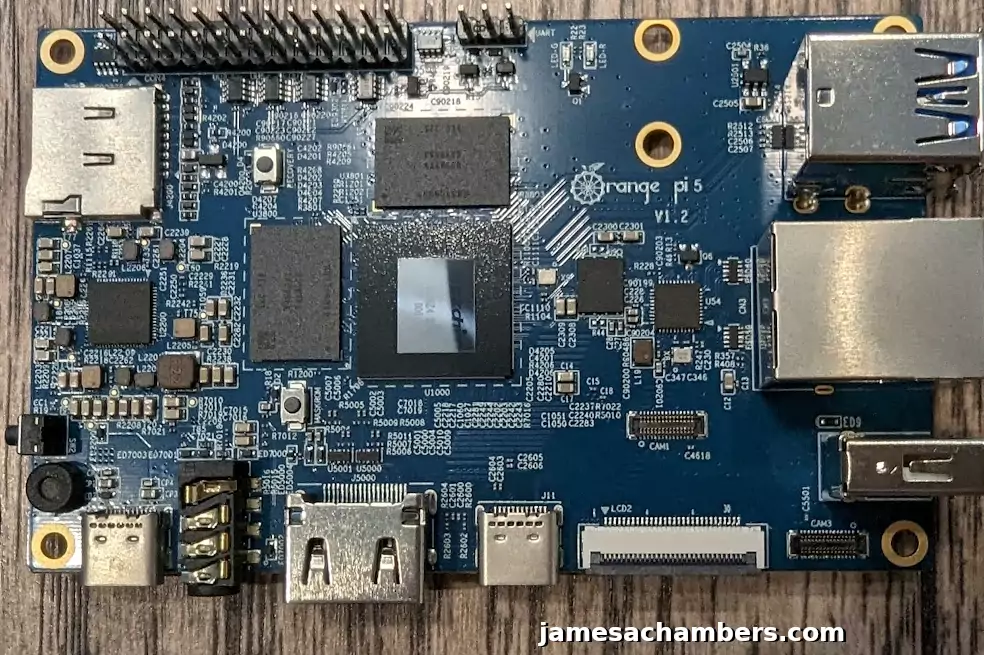
You can see the holographic effect on the RockChip CPU in the middle of the board. As you move it in the light you get a neat little effect.
The bottom of the board only contains a few connections such as the M.2 slot, a CAM slot and a couple others.
Here’s the bottom view:

I/O Benchmarking
For the review I used a SSSTC 128GB 2230 M.2 NVMe drive. These are available on Amazon for around $10-12 (also see Kioxia 128GB M.2 2230 module*).
You can verify the performance of your drive on Pi Benchmarks using the following command:
sudo curl https://raw.githubusercontent.com/TheRemote/PiBenchmarks/master/Storage.sh | sudo bashHere are the results:
Category Test Result
HDParm Disk Read 375.32 MB/s
HDParm Cached Disk Read 381.15 MB/s
DD Disk Write 234 MB/s
FIO 4k random read 47080 IOPS (188321 KB/s)
FIO 4k random write 35128 IOPS (140514 KB/s)
IOZone 4k read 75628 KB/s
IOZone 4k write 67285 KB/s
IOZone 4k random read 35874 KB/s
IOZone 4k random write 70620 KB/s
Score: 17,718
The full Orange Pi 5 benchmark can be viewed here on Pi Benchmarks.
That is an outstanding score. We are getting NVMe performance. This score actually even beats my ODROID M1 benchmark.
The Orange Pi 5 is without a doubt a very powerful board and is performing exactly where it should be.
Keep in mind that this is PCIe 2.0 performance. This board does not have PCIe 3.0 (only the RK3588 proper has that, not the RK3588S).
UPDATE 1/2/2023: If you update the Orange Pi 5 firmware by using sudo orangepi-config and choosing “System->Firmware” and then choose to update the firmware I was able to get *low* PCIe 2.0 performance (about 280MB/s). I highly recommend updating the firmware with sudo orangepi-config. You may see some marginal improvements!
Due to this you should not use a powerful NVMe drive with the Orange Pi 5. You are limited in speeds to around 500MB/s at best (according to Orange Pi themselves via the user manual) and more like 250MB/s write according to the benchmarking.
If you need help setting up SSD booting see my Orange Pi 5 SSD Boot Guide here.
Benchmarking vs. Pi 4 (added 12/16/2022)
I’ve now installed my heat sinks which looks like this:
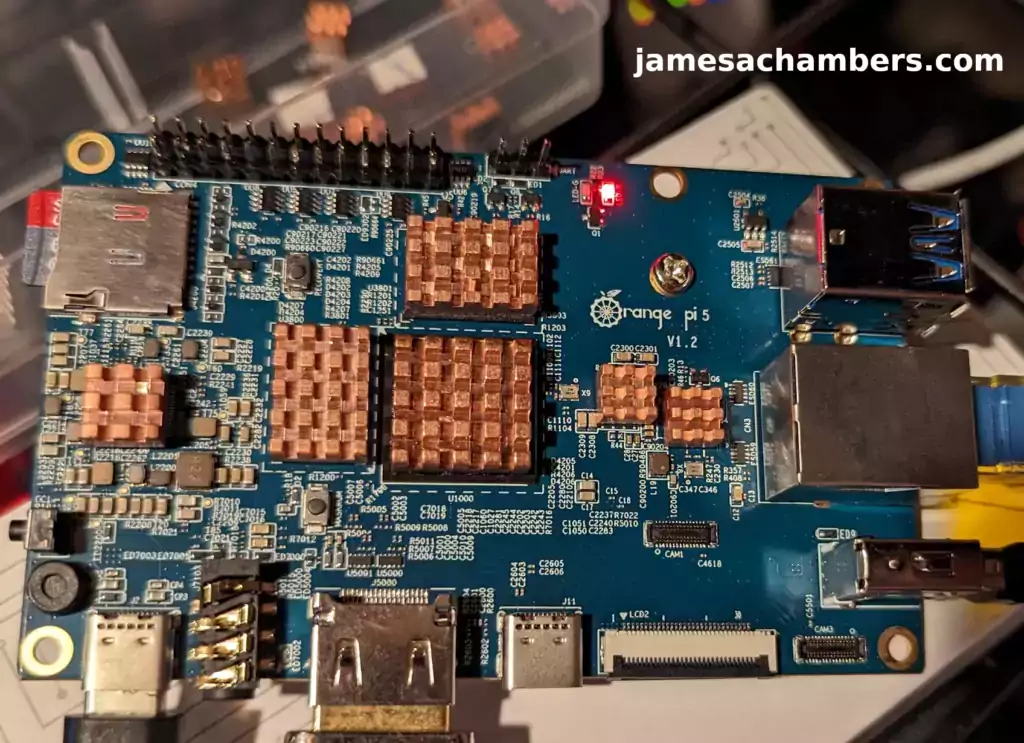
That means it’s time for a head-to-head benchmarking match against the Pi 4 to see how the Orange Pi 5 compares. For the benchmark I used the “hardinfo” benchmark which can be installed on most Linux flavors with:
sudo apt install hardinfoHere are the results:
| Test | Orange Pi 5 | Pi 4 |
| CPU Blowfish (lower is better) | 2.65s | 5.24s |
| CPU CryptoHash (higher is better) | 574.49 MiB/s | 466.37 MiB/s |
| CPU Fibonacci (lower is better) | 0.5s | 1.73s |
| CPU N-Queens (lower is better) | 4.24s | 8.74s |
| CPU Zlib (higher is better) | 0.80 | 0.31 |
| FPU FFT (lower is better) | 1.23s | 5.52s |
| FPU Raytracing (lower is better) | 2.86s | 2.18s |
| GPU Drawing (higher is better) | 2064.13 HiMarks | 1708.15 HiMarks |
That is almost a clean sweep for the Orange Pi 5! The only category it didn’t win was FPU raytracing interestingly enough. On GPU drawing performance however the Orange Pi 5 scored significantly higher and also won all other categories.
Pros / Cons
Pros
- 4 GB and 8 GB RAM variants cost under $100
- M.2 slot supports high speed NVMe storage
- RAM options from 4 GB all the way up to 32 GB available
Cons
- No WiFi or Bluetooth included (requires either adapter for the M.2 slot or a USB adapter to get WiFi/Bluetooth capabilities)
- No eMMC option
- PCIe speeds are limited to 500MB/s (PCIe 2.0, benchmarks show closer to 250MB/s write or PCIe 1.0 performance) — this is slower than SATA3
Conclusion
The Orange Pi 5 feels almost perfect except for the lack of built in WiFi / Bluetooth. This seems like a surprising choice on what seems like is portrayed as their “flagship” model. Fortunately it is easy to add WiFi/Bluetooth on the board via either the custom M.2 wireless PCB or by using one of your USB ports and just using a USB-based WiFi/BT chip.
The board performs extremely well. The GPU is powerful on the board and feels very snappy while using the desktop OS and applications. This board would be a good choice for almost any use case. It would make a great Minecraft server as well.
I’d recommend this one for just about anyone. The price is right. There are widely varying amounts of RAM available depending on what you need. There are good Linux and Android images available even at launch. At under $100 for the 4 GB – 8 GB the Orange Pi 5 is priced well in this market especially for the power and flexibility it offers!
Other Resources
I’ve also covered how to install Steam on the Orange Pi 5 here
I’ve also reviewed the Orange Pi portable monitor here (with the Orange Pi 5 connected)
If you’d like to use an alternative WiFi adapter see my E-key to M-key adapter guide here
Make sure to see my Orange Pi 5 SSD Boot Guide to see how to set up your NVMe drive to be the root partition for your OS
Don’t miss the rest of my single board computer reviews here
The Orange Pi Zero 2 is a great headless option from Orange Pi available for <$35 or so
I’ve also recently reviewed the Orange Pi 3 LTS which is a long term support variant equivalent in power roughly to a Pi 4

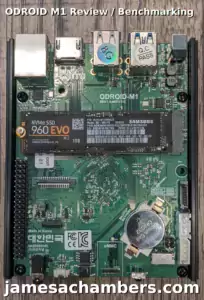

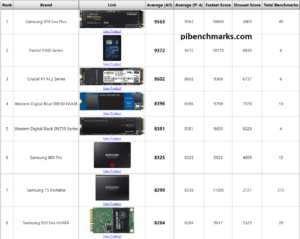
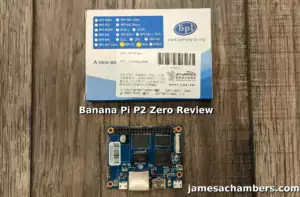
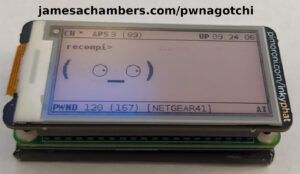
james
i have been following your page for 3 years, and posted my ssd results when it first came out. I’m now up to 3 OP5 – classic 4,8, and 4gb pro. Fantastic hardware esp RK3588S, These boards are near desktop class level performance, however its hard to find a true champion linux build for rockchip , all require some sort of janky fix for gpu… the pro version has some wifi armbian bugs as well. Github folks have gotten this to work well for desktop and emulation, and the next joy would be if it can do hardware transcoding for plex. Orangepi on the other hand doesn’t do much to offer support for gpu for its community, and i try to avoid its questionable but capable OS builds due to geopolitics. love your work, keep up the good fight.
Hey JBB,
Thank you so much, I’m delighted to hear you’ve ended up with 3 of them! They really are great boards. Definitely not perfect, but neither are any of their competitors.
I actually have not tried the pro version yet. Hopefully those bugs get ironed out. I totally understand about the geopolitics too. It may be an issue too if you’re trying to build a certified device.
For tinkerers / home hosting / those types of applications though it’s still the one to beat it would seem!
Hi Champ,
Thank you for the hard work you perform, its so appreciated.
I am really in doubt about whether to upgrade to Orange Pi 5(RK3588s) or Orange Pi 5 Plus(RK3588).
Or even upgrade at all from the RPI4-4GB i currently use. I understand it is faster, but i think the RPI4 is already plenty fast.
I run headless linux, wired ethernet, with many different docker containers. So i don’t need neither HDMI, audio, graphic performance etc etc.
So far the main differences i see:
1 Gbit -VS- 2,5Gbit (not needed for me)
Nvme PCI2 1x lane -VS- nvme PCI3 4x lane (maybe needed as docker system drive, would it speed things up?)
1 x USB3.0 port -VS- 2x USB 3.0 port (not needed, as I use USB3.0 hub already on RPI4)
I don’t see any tests on pibenchmarks.com for the RK3588.
Do you think the IOPS operation increase would give any meaningful upgrade on NVME, as opposed to the RPI4, which is connected to SSD (docker containers here) via USB3.
Either on the orange pi 5 or the 5 plus?
Also how stable is the board, and how is software support for headless operation. I have read that the kernel is 5.10, but is a huge mess based on some old 2.6 linux kernel, with 10000 patches.
Does this affect its headless performance in any way?
How is support for UASP, is there sleep support for external 2.5 SATA USB 3 enclosures.
The main upside to the RPI4 is the big community support and the stable software and kernel.
Hey UnknownInternetUser,
Absolutely! It’s much faster to use NVMe than to use a USB to NVMe adapter like we have to use with the Pi. You can see the results on pibenchmarks.com where the Orange Pi 5 pretty much crushes any Raspberry Pi setup.
Hopefully that helps!
Hi James,
Thank you for your amazing review.
Do you know if the Orange Pi 5 / 5B supports HDMI-CEC?
Thanks
Hey James,
The closest thing I found was here on reddit. I feel like the answer is probably not but there are workarounds such as going through other devices/adapters to accomplish it.
Hopefully that helps!
Greeting James,
I hope you’re doing well and thought I would alert you that Orange Pi look to be ready to release the full RK3588 SBC soon as reported by CNX Software.
Very competitive pricing to match that of the Nano-Pi T6 RK3588 SBC and just in time as Radxa have started shipping the Rock 5A to preorder backers but I’m convinced to go with the OPi 5+ especially if the current software support ports over from the OPi 5/5B!
Hey Razor Burn,
Thanks for the heads up, great to see you again! I agree with you about going with the OPI 5+. I really hope that the current software support ports over too. I’ll definitely keep an eye out for sure. Take care!
Hi James,
Hope you’re doing well mate.
It appears that Orange Pi have been super busy as the OPi 5+ has started shipping and they’re expanding the range of devices with their own Compute Module using the RK3566 chipset and talks of a future RK3588(S) version in a few months time which is really exciting so thought you might be interested…?
Take care and greetings from wintery Australia
Hey Razor Burn,
Great to see you! That’s very interesting news. I didn’t think Orange Pi was going to challenge Radxa in the Compute Module market so that’s an interesting turn of events! They’ve got details about the base board here and everything. I think it would be fun to check that one out!
Thanks for letting me know and take care!
Hi James, thanks for the excellent reviews and answering all the questions about the OPi5 board. I have bought myself one and installed RebornOS + XFCE on an m.2 nvme ssd. Everything works well until I tried to play a YouTube video in Firefox. It just won’t play any video even I set the resolution to as low as 144p, it just froze. If I simply hover the mouse cursor on one of the videos thumbnail on the YouTube main page, the thumbnail video could play though. It really surprised me as I chose RebornOS because some reviews said it had full GPU acceleration support. And even without GPU support I would guess the CPU itself could at least play some videos even if it wasn’t completely smooth? But no, it won’t play even a little. I then tried Armbian on a SD card, it plays 1080p YouTube smoothly. I’m wondering you or anyone else here had experience on using RebornOS on OPi5? As I really want an Arch-based Linux on it. Many thanks in advance!
Hey Sam,
Unfortunately for browsers having 3D support is browser specific. There’s a lot more to it than just having a 3D driver installed. Try going to the url:
about:supportScroll down to the graphics section. Take a look at the sections and it should probably be pretty obvious if anything is missing. You can also look at the “Decision Log” section right below it to see what decisions Firefox made to enable (or not enable) specific hardware acceleration features. I’d be surprised if any of them are working to be honest from what you’re describing.
That’s just where to start though. I wouldn’t have any idea on how to fix it for RebornOS for sure but it should give you enough technical details to start googling/searching on what packages and configuration you might need to do to get some of these features enabled.
If you’ve tested Chrome (I recommend testing it even though I use Firefox on my main x86_64 PC) the URL you would go to is:
chrome://gpuThis is a problem on all boards. Here’s a thread that I got a lot of those references for. Guess what it’s for though? The Raspberry Pi. Yes, this is always a problem on single board computers (even the Raspberry Pi). It’s extremely hard to get the 3D browser acceleration working on anything that doesn’t have a Intel, AMD or NVIDIA GPU. That’s nothing new unfortunately.
Most likely since this is Arch you are at the very least probably missing several 3D acceleration packages that may be necessary to do this. I was able to find some information about RebornOS for the Rock 5B. Obviously this is the Orange Pi 5 we are talking about but if you read through that thread you will see this is a really, really common problem on all boards.
One comment someone said:
dalekrebsJan 25
I installed mali-g610-firmware on R5b via RebornOS software install tool (welcome screen/utilities) it applied gpu acceleration to chromium and other applications. I rebooted and it worked great.
Well that certainly sounds promising. But even that guy had to install additional packages via the RebornOS software install tool utilities and apply the GPU acceleration to Chromium and “other applications”. This doesn’t work out of the box and Arch isn’t really an “out-of-the-box” type of operating system to be honest with you. The thing people like about Arch is that you have to configure and build everything (at least historically). Even Armbian won’t come with this though out of the box.
I’d honestly start with Chromium first when you run your tests. That’s far more likely to be the one that gets any acceleration love. You may find that neither of them have any of it enabled though meaning you need to use RebornOS’s utilities to enable this. It’s not default. I don’t see anyone claiming that and I can find a lot of sources to the contrary. They have some special tool to enable this so if that hasn’t been ran then that is the place to start.
The interesting thing is that Armbian doesn’t come with 3D support enabled either. It’s interesting that was working so much better than RebornOS if you didn’t install the 3D support packages (not included). I’d imagine you’re going to find in the Chrome / Firefox information menus I referenced earlier that for some reason your RebornOS install will be in worse shape than even the default Armbian install. If you had installed Armbian 3D support as per the Orange Pi 5 download page with the “Enable 3D acceleration” warning near the bottom of the page but before the “Other Supported Variants” section:
sudo add-apt-repository ppa:liujianfeng1994/panfork-mesasudo add-apt-repository ppa:liujianfeng1994/rockchip-multimedia
sudo apt update
sudo apt dist-upgrade
sudo apt install mali-g610-firmware rockchip-multimedia-config
I wonder how much better it would have performed. Notice that one of the packages installed to make this work on Armbian is mali-g610-firmware. That’s another one that came up in my Arch-related links earlier. It’s not going to be on there it doesn’t sound like no matter what you may have heard elsewhere and again it is *not* included with Armbian. You have to do the above steps to enable it.
There must be some more fundamental things missing on the RebornOS install but my understanding is this should be fixable (just like Armbian) by installing the proper packages. This was a very good / smart test to run though. You may even want to compare the Firefox and Chrome menus telling what is accelerated on each in Armbian vs. RebornOS to figure out what is missing on the Arch system.
It’s great that you did the Armbian test. Hopefully some of those tips / links will help you narrow this down. If you wouldn’t mind letting us know what you found that would be greatly appreciated. If it ends up being something as simple as running the RebornOS software install tools to just turn it on then that’s actually great and not too difficult to deal with (if it’s true).
Hopefully that helps!
Hi James, thank you for taking your time to help me. I have done quite a few things to troubleshoot. I can’t believe I have wasted so much time trying to fix this problem, and haven’t done the most basic thing – uninstalled the mali-g610-firmware and reinstall it again. I just did it, it works like a charm…….. I’m both happy that the system work perfectly now and sad about how stupid I was…….. and I’m sorry I have wasted your time. At least next time when someone asks you the same thing, you can tell them to do the most basic thing – uninstall the driver and reinstall it again, it fixes everything!
I guess the problem was due to the fact that I originally install the RebornOS with Gnome, and then I didn’t like Gnome and removed it and installed XFCE. Uninstalling Gnome must have removed some drivers required for playing YouTube. Again please accept my apology.
Sam
Hey Sam,
Great work, truly, and thanks for sharing this outcome! This actually makes a lot of sense. The freezing seemed way too serious. As you observed on Armbian even without the 3D support enabled it can still do 1080P fairly easily unaccelerated. It won’t be perfect without any acceleration but the freezing did seem like an actual error/problem.
I think you’re completely right about how this happened. Removing a previous desktop system / desktop manager can sometimes mark the packages as unavailable. When a new desktop system or manager is installed these aren’t reinstalled automatically as these are special packages that aren’t included by default.
Thanks so much for sharing this. Enjoy and take care!
Hi James,
The price for the Orange Pi 5B is higher than for the Orange Pi 5 due to the eMMC flash and wireless module with four models currently for sale:
$89.90 for 4GB RAM and 32GB eMMC flash
$115.00 for 8GB/64GB configuration
$149.00 for 16GB/128GB configuration
$169.00 for 16GB/256GB configuration
CNX-Software
Hey Razor Burn,
Thanks for the update! It’s not too bad of a deal for people who don’t want to use NVMe. It is definitely cheaper than buying the separate WiFi module. The Orange Pi 5 has been about $88 on Amazon.com for a while here.
I think it makes a ton of sense for them to offer this model. You either have to choose between WiFi and NVMe either way. If you buy the WiFi version of the board you don’t have to worry about the additional module and you’ll get a eMMC on top of it. Not a bad deal at all.
Thanks for sharing this! We’ll have to see when it’s available to order here (I don’t see it on Amazon yet). Take care!
Amazon links can be found on the official website for preorder – 26th March 2023?
http://www.orangepi.org/html/hardWare/computerAndMicrocontrollers/details/Orange-Pi-5B.html
Not sure what to make of the price as $169.00 is somewhat expensive when you factor in that you can order a Radxa Rock 5B 16GB from allnetchina for $189.00 (without accessories/shipping) and you get the full RK3588 I/O!?
It will be interesting to see the comparisons and how much of an improvement eMMC is for booting software and read/write speeds compared to NVMe but otherwise it should function the same once developers tweek the software.
Take care!
Hey Razor Burn,
Oh wow, it’s actually a lot more expensive. It starts at $99 for the 4GB. Meanwhile $107 will land you the 8GB Orange Pi 5 from Amazon. This is exactly why I wanted to see the listing. I’ve never seen an Orange Pi sold as cheap as the prices on CNX-Software.
I actually don’t think I can afford to pre-order this one right now. I’ve been interviewing to go back to work because although I’m making enough to pay my mortgage and bills from the site there’s no money left over to buy new gear so I’m kind of stuck. America is a particularly unforgiving place to be poor/broke and the economy looks like it’s going off the rails here. This may slow down my publishing in the short term over the next couple of months but once I’m loaded on cash again it will actually increase it because it will give me access to a lot more gear.
I’m so glad you had the actual listing. There is a big premium on this. A lot bigger than the article made it sound!
Sorry to read that James and I can certainly sympathise as cost of living pressures make this hobby quite expensive and when its your lively hood it gets even harder so I wish you success and hope to see some new reviews soon. Take care good sir!
Hey Razor Burn,
No worries at all, I think it will be a good thing. My role will be an IT Engineer so I will be learning a lot and working with expensive enterprise technologies that I normally would never be able to buy and cover on the site. I’ll definitely make sure to keep publishing regardless.
Thanks and take care!
I still prefer the NVME version with a cheap 256GB SSD, and my free wifi module taken from an old sky box!
Hey Tony,
I think a lot of people will agree. I’m using a 128GB cheap NVMe SSD with mine and it’s my new Home Assistant server. I’m not sure how fast the eMMC will be on the device but it won’t be as fast as NVMe. Not even close.
The technical explanation for this is that there is not enough PCIe I/O on the RK3588S to have both. You have to choose one or the other. If you buy the Orange Pi 5 they give you the slot and you have a choice. You either have to pay extra for a WiFi module or you have the option of using NVMe.
The Orange Pi 5B takes that choice away of course. They just put the WiFi directly on the board. This didn’t solve the problem though of the RK3588S not having enough I/O to have both options. In other words buying the Orange Pi 5B makes the choice for you and comes with the WiFi module and no option to use NVMe.
The Orange Pi 5 WiFi adapter is up to $26 on Amazon (I am certain it was less than that when it first released). I don’t think this is a coincidence. I think this is the whole reason the Orange Pi 5B exists. I think that custom WiFi module was probably incredibly expensive to produce. They were giving it away for half that price when it first came out (probably taking 0% profit from it and giving it away at cost).
I suspect what has happened is that the custom WiFi module was so expensive for them to produce that they literally don’t want to go that route anymore. They’re discouraging it by raising the price on it and telling people to buy the 5B if they want WiFi. They wouldn’t have done this if it wasn’t better / cheaper for them to do it this way. We had to wait at least a couple of months before the custom WiFi module was even available after launch as well so it definitely caused some headaches.
Since it can’t take a normal E-key adapter like the Radxa Rock 5B though their only option was literally producing a “custom” WiFi module that plugs into a slot that WiFi adapters aren’t supposed to plug into traditionally (M-key). Normal WiFi adapters are E-key. As many of you know though any time you need a custom solution that means a lot more $$$. Even if you’re Orange Pi.
In other words I bet they regret launching it this way and doing the custom WiFi module for the Orange Pi 5. I bet if they had done the launch again it would have always been offered as the 5 or 5B right from the very beginning and the custom WiFi module would have never existed. It would have just been marketed as one of them is the WiFi option and one isn’t.
I wouldn’t be surprised if the custom WiFi module goes away or continues to become more expensive to retrofit the Orange Pi 5 with it. They’ll just be encouraging people to get the WiFi (5B) version of the board. There’s no way they would have gone in this direction this quickly unless they made a single run of the custom WiFi module and noped out. They literally decided it would be better for them to make a new board for it rather than continue to go down that road. I suspect the custom WiFi module will go unavailable once they’re out of them (or it will go even higher in price than $26.99).
Take care!